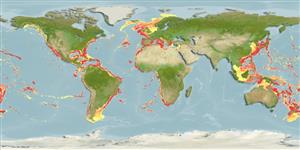Common names from other countries
Environment: milieu / climate zone / depth range / distribution range
экология
пелагический; пределы глубины 0 - 1600 m (Ref. 116114). Tropical
Indo-Pacific, Atlantic Ocean, and the Mediterranean.
Length at first maturity / Size / Вес / Возраст
Maturity: Lm ? range ? - ? cm Max length : 9.0 cm WD самец/пол неопределен; (Ref. 2376)
Up to 6.5 cm wide; nematocyst warts on exumbrella very variable in size and number. Color very variable.
Neritic, estuarine, potentially pathogenic (Ref. 116114). A holoplanktonic, oceanic and semi-cosmopolitan species (Ref. 19) inhabiting offshore warm waters (Ref. 813); non symbiotic but often appears in high numbers (Ref. 7694). Feeds on salps, doliolids, larvaceans, hydromedusae, ctenophores, chaetognaths, planktonic crustaceans and fish eggs (Ref. 2376).
Life cycle and mating behavior
половая зрелость | размножение | нерест | икра | Fecundity | личинки
Members of the class Scyphozoa are gonochoric. Life cycle: Egg is laid by the adult medusa which later develops into a free-living planula, then to a scyphistoma to a strobila, and lastly to a free-living young medusa.
Основная ссылка
ссылки | координатор | соавторы
Migotto, A.E., A.C. Marques, A.C. Morandini and F.L. da Silveira. 2002. (Ref. 813)
Статус Красного Списка МСОП (Ref. 130435)
Статус СИТЕС (Ref. 108899)
Not Evaluated
Not Evaluated
Использование человеком
| FishSource |
инструменты
дополнительная информация
ресурсы в Интернет
Estimates based on models
Preferred temperature
(Ref.
115969): 3.1 - 12.5, mean 7.1 (based on 1107 cells).
Уязвимость
Low vulnerability (10 of 100).
Категория цены
Unknown.
